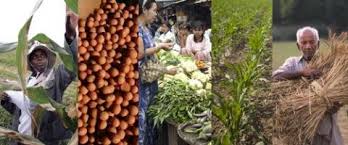The Nexus between Agriculture, Food Security and Climate Change in Ethiopia
Keywords:
Climate Smart Agriculture, Food Security, Climate Change, Environment, EthiopiaAbstract
This paper focuses mainly on assessing the food security-agriculture-climate change nexus and provides multidisciplinary scientific assessment and recommendations for sustainable agro ecological solutions in the quest of humanity to sustainable development. While agriculture tend to support the overwhelming majority of the population in every part of Africa in general and in Ethiopia in particular, climate change in itself will very likely affect four key dimensions of the food security including availability, accessibility, utilization and sustainability of the food, due to close linkage between food and water security and climate change. The impacts of climate change and increases in climate variability on agricultural systems and natural-resource-dependent households, as well as on food security and the future vulnerability of already hungry people in Ethiopia and of course in most of the developing countries in Africa, are highlighted in the paper. It is also worth mentioning that, the role of climate-smart agriculture can be used for mitigating and adapting the impacts of projected climate change. CSA brings together practices, policies and institutions that are not necessarily new but are used in the context of climatic changes. Furthermore, it addresses challenges faced by triple interplay of agriculture, food security and climate change simultaneously and holistically.
References
ANRS (Afar National Regional State) (2010). Programme of Plan on Adaptation to Climate Change. 74p.
Arslan A. 2014. Climate-Smart Agriculture; Climate change, agriculture and food security, EPIC – FAO, Centre for Development Innovation.
Arsano Y, Tamrat I. 2005 Ethiopia and the Eastern Nile Basin. Aquat. Sci. 67, 15–27. (doi:10.1007/s00027-004-0766-x).
Burchi, F., Fanzo, J. & Frison, E. 2011. The role of food and nutrition system approaches in tackling hidden hunger. International Journal Environ. Res. Public Health.
Cafiero C, 2012 “Advances in hunger measurement. Traditional FAO methods and recent innovations”. Global Food Security. 2012.
De Janvry A, Sadoulet E, 2010. Agricultural growth and poverty reduction: additional evidence. World Bank Res Obs 25 (1), 1-20.
Eshetu C. 2004 The underdevelopment of Ethiopia. Addis Ababa, Ethiopia: Organization for Social Science Research in Eastern and Southern Africa.
Ericksen, P., Thornton, P., Notenbaert, A., Cramer, L., Jones, P. and Herrero, M. 2011. Mapping hotspots of climate change and food insecurity in the global tropics. CCAFS Report 5. Copenhagen, Denmark: CCAFS.
FAO, 1996 The Sixth World Food Survey. Rome, FAO.
Hurni, H. 1988. Degradation and conservation of the resources in the Ethiopian highlands.
Mountain Research and Development 8(2/3): 123-130.
IFAD, 2011. Rural Poverty Report 2011. New realities, new challenges: new opportunities for tomorrow's generation. International Fund for Agricultural Development (IFAD), Rome.
Kassaye H (2010). Climate change and the vulnerability context of livestock and impacts on livestock based livelihoods in Ethiopia: the veterinary agenda. In: Proceedings of the 24th Annual conference of the Ethiopian veterinary Association.July21-22, Addis Ababa, Ethiopia.
MacDonald M and Simon J (2011). Climate, food security, & growth Ethiopia’s complex relationship with livestock. Policy Brief 3. Brighter Green.
ONRS (Oromia National Regional State) (2011). Program of Plan on Adaptation to Climate Change. February,2011. Finfinne (Addis Ababa). 97p.

Published
How to Cite
Issue
Section
Copyright (c) 2015 Mohammed Yimer

This work is licensed under a Creative Commons Attribution-NonCommercial-NoDerivatives 4.0 International License.



